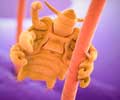According to lead researcher Stephen Barker, Associate Professor from the University of Queensland, animals have two types of chromosomes, the nucleic and the mitochondrial.

And on most animals the mitochondrial chromosome contains 37 genes.
However, the genome sequencing of head lice has revealed the 37 genes are located on 12 or more mini-chromosomes that join and separate.
"Instead of living in one house it is like they are living in a little village of 12 houses," ABC Online quoted Barker as saying.
"It shows they are incredibly sophisticated and generally quite extraordinary," he added.
According to co-author Dr Renfu Shao, the mini-chromosomes "seem to sit at the summit of mitochondrial chromosome evolution".
Advertisement
Barker says that this genetic structure is exclusive to head lice.
Advertisement
"These mini-chromosomes are only found in the lice that infect primates [including humans]," he added.
The researchers say that the evolutionary tree of louse dates back to 22.5 million years ago.
"The point of this is it's not a flash in the pan - [the chromosome structure] evolved about 20 million years ago and it still exists," Barker said.
Barker says the team is now investigating the implications of their find.
"We've described the pattern and now we are trying to understand how they use this and whether they so have some advantage to the insect," he added.
The paper will be published in Genome Research.
Source-ANI
SAV









